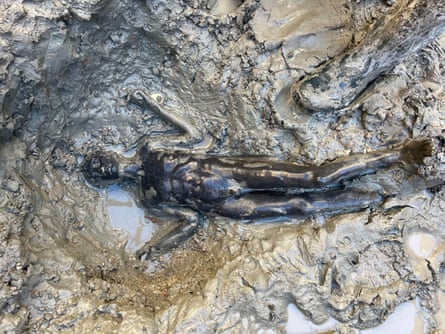‘Exceptional’ trove of 24 ancient statues found immersed in Tuscan spa | Italy
An “exceptional” trove of bronze statues preserved for thousands of years by mud and boiling water have been discovered in a network of baths built by the Etruscans in Tuscany.
The 24 partly submerged statues, which date back 2,300 years and have been hailed as the most significant find of their kind in 50 years, include a sleeping ephebe lying next to Hygeia, the goddess of health, with a snake wrapped around her arm.
Archaeologists came across the statues during excavations at the ancient spa in San Casciano dei Bagni, near Siena. The modern-day spa, which contains 42 hot springs, is close to the ancient site and is one of Italy’s most popular spa destinations.

Close to the ephebe (an adolescent male, typically 17-18 years old) and Hygeia was a statue of Apollo and a host of others representing matrons, children and emperors.
Believed to have been built by the Etruscans in the third century BC, the baths, which include fountains and altars, were made more opulent during the Roman period, with emperors including Augustus frequenting the springs for their health and therapeutic benefits.
Alongside the 24 bronze statues, five of which are almost a metre tall, archaeologists found thousands of coins as well as Etruscan and Latin inscriptions. Visitors are said to have thrown coins into the baths as a gesture for good luck for their health.
Massimo Osanna, the director general of museums at the Italian culture ministry, said the relics were the most significant discovery of their kind since two full-size Greek bronzes of naked bearded warriors were found off the Calabrian coast near Riace in 1972. “It is certainly one of the most significant discoveries of bronzes in the history of the ancient Mediterranean,” Osanna told the Italian news agency Ansa.

The excavation project at San Casciano dei Bagni has been led by the archaeologist Jacopo Tabolli since 2019. In August, several artefacts, including fertility statues that were thought to have been used as dedications to the gods, were found at the site. Tabolli, a professor at the University for Foreigners of Siena, described the latest discovery as “absolutely unique”.
The Etruscan civilisation thrived in Italy, mostly in the central regions of Tuscany and Umbria, for 500 years before the arrival of the Roman Republic. The Etruscans had a strong influence on Roman cultural and artistic traditions.
Initial analysis of the 24 statues, believed to have been made by local craftsmen between the second and first centuries BC, as well as countless votive offerings discovered at the site, indicates that the relics perhaps originally belonged to elite Etruscan and Roman families, landowners, local lords and Roman emperors.

Read More: ‘Exceptional’ trove of 24 ancient statues found immersed in Tuscan spa | Italy
